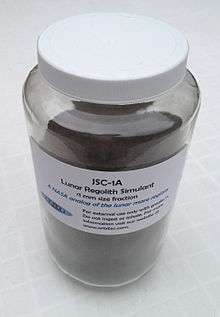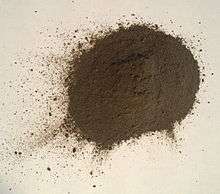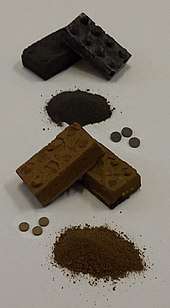Lunar regolith simulant
A lunar regolith simulant is a terrestrial material synthesized in order to approximate the chemical, mechanical, or engineering properties of, and the mineralogy and particle size distributions of, lunar regolith.[1] Lunar regolith simulants are used by researchers who wish to research the materials handling, excavation, transportation, and uses of lunar regolith. Samples of actual lunar regolith are too scarce, and too small, for such research.


Early simulants
In the run-up to the Apollo program, crushed terrestrial rocks were first used to simulate the anticipated soils that astronauts would encounter on the lunar surface.[2] In some cases the properties of these early simulants were substantially different from actual lunar soil, and the issues associated with the pervasive, fine-grained sharp dust grains on the Moon came as a surprise.[3]
Later simulants
After Apollo and particularly during the development of the Constellation program, there was a large proliferation of lunar simulants produced by different organizations and researchers. Many of these were given three-letter acronyms to distinguish them (e.g., MLS-1, JSC-1), and numbers to designate subsequent versions. These simulants were broadly divided into highlands or mare soils, and were usually produced by crushing and sieving analogous terrestrial rocks (anorthosite for highlands, basalt for mare). Returned Apollo and Luna samples were used as reference materials in order to target specific properties such as elemental chemistry or particle size distribution. Many of these simulants were criticized by prominent lunar scientist Larry Taylor for a lack of quality control and wasted money on features like nanophase iron that had no documented purpose.[4]
JSC-1 and -1A
JSC-1 (Johnson Space Center Number One) was a lunar regolith simulant that was developed in 1994 by NASA and the Johnson Space Center. Its developers intended it to approximate the lunar soil of the maria. It was sourced from a basaltic ash with a high glass content.[1]
In 2005, NASA contracted with Orbital Technologies Corporation (ORBITEC) for a second batch of simulant in three grades:[5]
- JSC-1AF, fine, 27 µm average size
- JSC-1A, a reproduction of JSC 1, less than 1 mm size
- JSC-1AC, coarse, a distribution of sizes < 5 mm
NASA received 14 metric tons of JSC-1A, and one ton each of AF and AC in 2006. Another 15 tons of JSC-1A and 100 kg of JSC-1F were produced by ORBITEC for commercial sale, but ORBITEC is no longer selling simulants and was acquired by the Sierra Nevada Corporation. An 8-ton sand box of commercial JSC‐1A is available for daily rental from the NASA Solar System Exploration Research Virtual Institute (SSERVI).[6]
JSC-1A can geopolymerize in an alkaline solutions resulting in a hard, rock-like, material.[7][8] Tests show that the maximum compressive and flexural strength of the 'lunar' geopolymer is comparable to that of conventional cements.[8]

JSC-1 and JSC-1A are now no longer available outside of NASA centers.
NU-LHT and OB-1
Two lunar highlands simulants, the NU-LHT (lunar highlands type) series and OB-1 (olivine-bytownite) were developed and produced in anticipation of the Constellation activities. Both of these simulants are sourced mostly from rare anorthosite deposits on the Earth. For NU-LHT the anorthosite came from the Stillwater complex, and for OB-1 it came from the Shawmere Anorthosite in Ontario. Neither of these simulants were widely distributed.
Recent simulants
Most of the previously developed lunar simulants are no longer being produced or distributed outside of NASA. Multiple companies have tried to sell regolith simulants for profit, including Zybek Advanced Products, ORBITEC, and Deep Space Industries. None of these efforts have seen much success. NASA is unable to sell simulants, or distribute unlimited amounts for free; however, NASA can award set amounts of simulant to grant winners.
Several lunar simulants have been developed recently and are either being sold commercially or are available for rent inside large regolith bins. These include the OPRL2N Standard Representative Lunar Mare Simulant[9] and Standard Representative Lunar Highland Simulant.[10] Off Planet Research also produces customized simulants for specific locations on the Moon including lunar polar icy regolith simulants that include the volatiles identified in the LCROSS mission.
Other simulants include Lunar Highlands Simulant (LHS-1)[11] and Lunar Mare Simulant (LMS-1)[12] produced and distributed by the not-for-profit Exolith Lab run out of the University of Central Florida.[13]
See also
References
- David S. McKay; James L. Carter; Walter W. Boles; Carlton C. Allen & Judith H. Allton (1994). "JSC-1: A new lunar soil simulant" (PDF). In Rodney G. Galloway & Stanley Lokaj (eds.). Engineering, Construction, and Operations in Space IV; Proceedings of the 4th International Conference, Albuquerque, New Mexico, February 26–March 3, 1994. 2. New York: American Society of Civil Engineers. pp. 857–866. ISBN 0872629376.
- Salisbury, John (1964). "Studies of the Characteristics of Probable Lunar Surface Materials". Air Force Cambridge Research Laboratories (U.S.) Special Reports. 20.
- Gaier, James (2005). "The Effects of Lunar Dust on EVA Systems During the Apollo Missions" (PDF). NASA Technical Reports (2005–213610).
- Taylor, Lawrence; Pieters, Carle; Britt, Daniel (2016). "Evaluations of lunar regolith simulants". Planetary and Space Science. 126: 1–7. Bibcode:2016P&SS..126....1T. doi:10.1016/j.pss.2016.04.005.
- http://isru.msfc.nasa.gov/lib/workshops/2009/03_JSC-1A_Lunar_RegSimulant_Update_BGustafson.pdf
- NASA Solar System Exploration Research Virtual Institute (SSERVI)
- Montes, Broussard, Gongre, Simicevic, Mejia, Tham, Allouche, Davis; Evaluation of lunar regolith geopolymer binder as a radioactive shielding material for space exploration applications, Adv. Space Res. 56:1212–1221 (2015)
- Alexiadis, Alberini, Meyer; Geopolymers from lunar and Martian soil simulants, Adv. Space Res. (2017) 59:490–495, doi:10.1016/j.asr.2016.10.003
- OPRL2N Standard Representative Lunar Mare Simulant
- OPRH2N Standard Representative Lunar Highland Simulant
- Lunar Highlands Simulant (LHS-1)
- Lunar Mare Simulant (LMS-1)
- Exolith Lab
Further reading
- Bonnie Cooper (2007). "Appendix C: Lunar soil simulants". In David G. Schrunk; Burton L. Sharpe; Bonnie L. Cooper; Madhu Thangavelu (eds.). The Moon: resources, future development, and settlement (2nd ed.). Springer. pp. 257–268. ISBN 9780387360553.
- P Carpenter; L Sibille; S Wilson; G Meeker (2006). "Development of Standardized Lunar Regolith Simulant Materials". Microscopy and Microanalysis. 12 (Suppl. 02) (S02): 886–887. Bibcode:2006MiMic..12..886C. doi:10.1017/S143192760606301X.
- D. S. McKay; J. L. Carter; W. W. Boles; C. C. Allen & J. H. Alton (1993). "JSC-1: A new lunar regolith simulant". Lunar and Planetary Science XXIV. Lunar and Planetary Science Conference. pp. 963–964. Bibcode:1993LPI....24..963M.
- J. Ledlie Klosky; Stein Sture; Hon-Yim Ko & Frank Barnes (1996). "Mechanical Properties of JSC-1 Lunar Regolith Simulant". In Stewart W. Johnson (ed.). Engineering, Construction, and Operations in Space 5: Proceedings of the Fifth International Conference on Space ’96 held in Albuquerque, New Mexico, June 1–6, 1996. New York: American Society of Civil Engineers. pp. 680–688. doi:10.1061/40177(207)94). ISBN 0784401772.
- Yongchun Zheng; Shijie Wang; Ziyuan Ouyang; Yongliao Zou; Jianzhong Liu; Chunlai Li; Xiongyao Lia; Junming Feng (2009-02-02). "CAS-1 lunar soil simulant". Advances in Space Research. 43 (3): 448–454. Bibcode:2009AdSpR..43..448Z. doi:10.1016/j.asr.2008.07.006. — also: